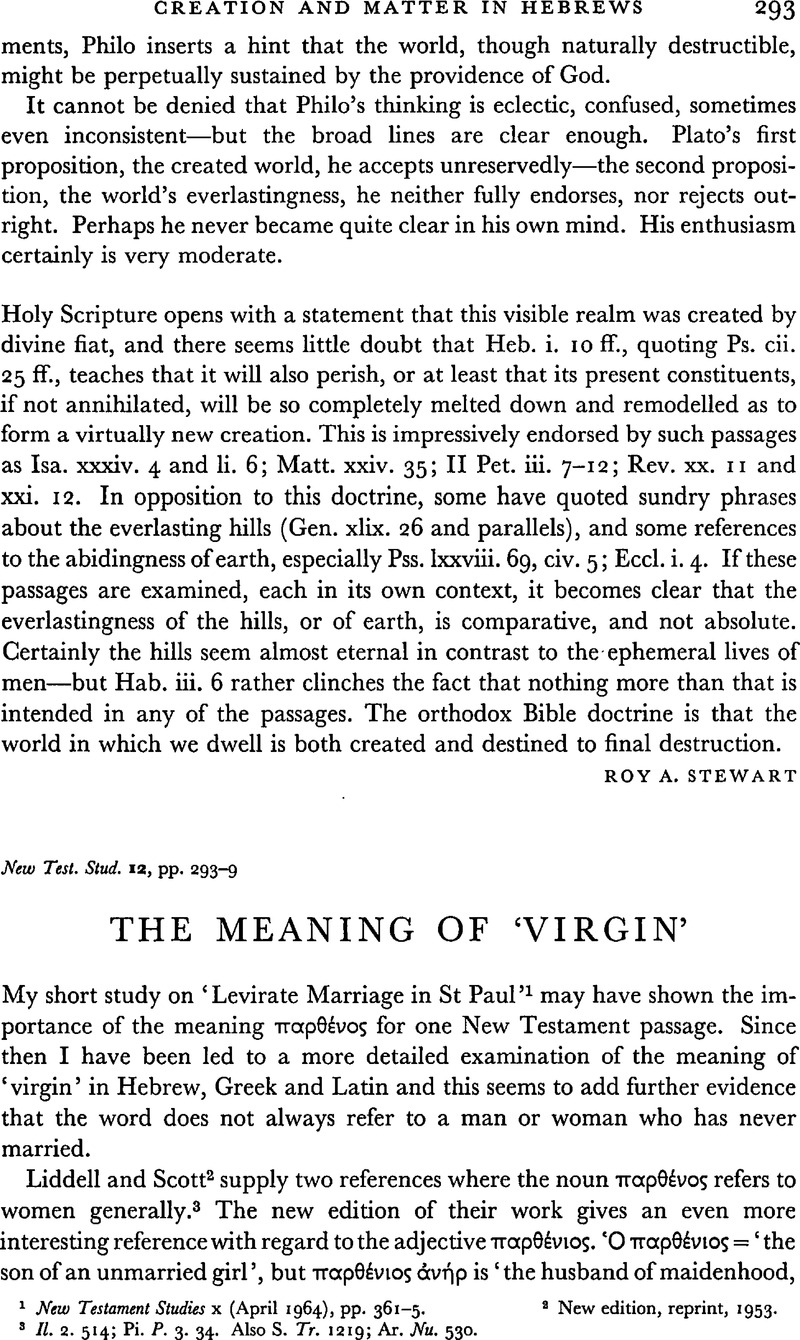No CrossRef data available.
Published online by Cambridge University Press: 05 February 2009

page 293 note 1 New Testament Studies x (04 1964), pp. 361–5.Google Scholar
page 293 note 2 New edition, reprint, 1953.Google Scholar
page 293 note 3 Il. 2. 514; Pi. P. 3. 34. Also S. Tr. 1219; Ar. Nu. 530.Google Scholar
page 294 note 1 Plu. Pomp. 74.Google Scholar
page 294 note 2 Leon, H., The Jews of Ancient Rome (Philadelphia, 1960), p. 230Google Scholar. Professor Leon (ibid.) comments that it is interesting that the words Παρθενκός and ‘virginius’ are apparently used of a spouse who had not been married before. One may compare Luke ii. 36 where the phrase άΠό Τής Παρθενας seems to be equivalent to Παρθενκός.
page 294 note 3 Professor D. Daube has observed in a conversation with me that the is not used with reference to legitimate relationships between husband and wife. He remarks that ‘one passage in Genesis Rabba 9 might seem to tend that way, where Samuel bar Nahman says that even the evil impulse is in a way good since, but for it, man would neither build a house, nor marry nor beget children nor trade. But the Rabbi [Professor Daube thinks] is here referring not to the sexual aspect but to possessiveness, greed, competition. This is clear from the various activities listed, and it is confirmed by the quotation of Ecc. iv. 4 “The jealousy between man and his fellow”.’ Indeed, I myself should add, the abundant evidence that marriage was regarded as a divine ordinance (for example, Keth. 62 b) and coitus a sacred act would argue against the use of μολύνω with reference to marriage, especially in a book as patently Jewish as the Apocalypse of John.Google Scholar
page 294 note 4 Texts, Biblia Hebraica, ed. Kittel, R. (11th ed. 1951); LXX, ed. Rahlfs, Alfred (2 vols. Stuttgart, 1952); also The Old Testament in Greek, ed. Brooke, A. E. and McLean, N., (Cambridge, 1906).Google Scholar
page 294 note 5 For example, Skinner, J., Genesis (I.C.C. Edinburgh, 1951).Google Scholar
page 294 note 6 Herbert, Danby, The Mishnah [trans.] (Oxford, 1933). Hebrew Text (no date).Google Scholar
page 295 note 1 Cf. also Nidd. v. 9 and Jastrow, M., Dictionary of Talmud. Babli. Terushalmi. Midrashic Literature and Targumim (New York, 1950) under. All references to the Babylonian Talmud are from the Soncino translation (London, 1936). No Hebrew text is available in East Africa.Google Scholar
page 295 note 2 , a girl of the age of twelve to twelve and a half.Google Scholar
page 295 note 3 Text, Corpus Christianorum (Turnhout, 1954).Google Scholar
page 296 note 1 Ante-Nicene Fathers, ed. Roberts, A. and Donaldson, J. (New York, 1890).Google Scholar
page 296 note 2 For the Jewish influence on the African Church see Frend, W. H. C., ‘The Seniores Laici and the Origins of the Church in North Africa’, J.T.S. n.s. xII (1961), 280–4 and the references there cited.Google Scholar
page 296 note 3 Text, Sources Chrétiennes x (1951) (ed. Camelot, Th.).Google Scholar
page 297 note 1 Note 8, p. 610 (T.B. Keth. 96 a).Google Scholar
page 298 note 1 See above, p. 294.Google Scholar
page 298 note 2 Marc, Philonenko, ‘Le Testament de Job et les Thérapeutes’, Semitica vIII (1958), 46.Google Scholar
page 298 note 3 Black, M., The Scrolls and Christian Origins (New York, 1961), p. 83.Google Scholar
page 298 note 4 I have no original text of the Pseudo-Clementine epistles concerning virginity but the translator himself confesses that he uses the word ‘virgin’ in an ambiguous way and does not distinguish between men and women virgins (Ante-Nicene Fathers vIII, 55–66).Google Scholar
page 298 note 5 Voöbus, A., ‘Celibacy, a requirement for Admission to Baptism in the early Syrian Church’ (Stockholm, 1951). I read this article some years ago but it is unobtainable in East Africa and therefore I am unable to enlarge on this point.Google Scholar
page 299 note 1 I have commented on I Cor. vii. 34 in an article, ‘St Paul, the Philogamist’ (N.T.S. xi (1965). PP. 326ff.).Google Scholar
page 299 note 2 For example, The Liturgy of St James, Peter of Alexandria: P.G. 18: 517; Athanasius, Adv. Arian. a: 70; P.G. 26: 296 etc.Google Scholar
page 299 note 3 I believe that the term ΠανΠάρθενος is also used for Mary but I have been unable to trace this owing to the paucity of patristic texts in East Africa.Google Scholar